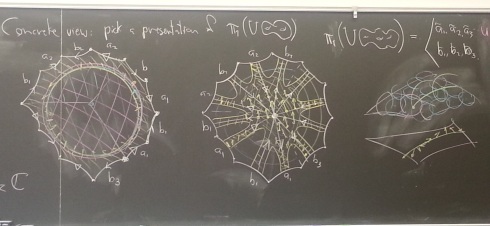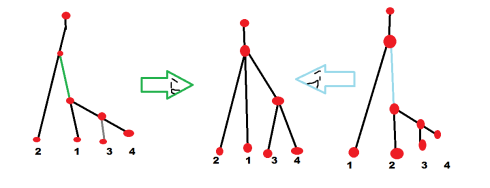This may come as a surprise to you, but I’ve decided after much soul searching this year that I will not be applying for postdocs this fall and following the steps to success in mathademia. Please do not take this as an indictment of academia (though I also feel that; each of those words is a separate link about academia & motherhood), and I highly recommend postgraduate study in math if you’re interested in it (so does Evelyn Lamb on Slate!)
I have loved my time doing something I love on a flexible schedule which gave me lots of time to spend with my son, organize conferences, travel, blog, bake, exercise, and have the life I wanted. It’s also been very difficult to have the highly unstructured environment, little oversight, and lack of regular collaboration. Also very little money, but I married a person with an actual job so he can support the kid, and as a young 20-something I didn’t need much money (especially with math conferences covering travel and accommodation costs!) So I love math, I love mathademia, but I don’t love teaching enough to do it full-time yet, and I don’t love research enough to want to move my family only to move them again 3 years later, and possibly 3 years after that again. Hence I am starting my non-academic job search, and I thought y’all could join me on my journey.
When I first started toying with leaving academia, a friend of mine who also has a Ph.D. in math told me: the hardest thing about leaving academia is deciding to leave academia. It’s been several months of pro/con lists, discussions with friends and family, and days of feeling sad and hopeless vs. days of feeling inspired. You can’t help but feel like a failure when you make this decision, because all the exemplars of success that surround you are academics. And that’s not even true for me; I try to know a range of people who do different things, but still in my day to day life and work it’s all professors etc. Anyways, I got through this stage but it was rough.
Next I got some books! Specifically, In Transition and What Color is Your Parachute? + Workbook. I’d heard of Parachute, and I talked to a friend on the phone who used to be in consulting who said that everyone who left his company was given a copy of In Transition. So I spent a few weeks working through these, which was mostly about soul-searching and there’s some practical advice in there about informational interviews. In those weeks I also contacted career services at Yale (they have someone dedicated to alumni) and UT Austin and got some short and helpful advice.

I rejoined Amazon affiliates so I could put these pictures in this post. Buy the books from links above, I get money!
After using the books and career people and narrowing down to a few fields that might interest me, I used LinkedIn and the internet to find companies in those fields in the locations I’m interested in (Austin, where we are now, and where our families are). After a few days of searching, that got me a list of 50 or so companies in a file I called “first impressions”, which I then went through again and checked out all of their websites which took another several days. I deleted all the ones I couldn’t imagine working for or which didn’t exist anymore, which brought me to a list of about 20 companies.
I figured once I started contacting people they’d google me, so I updated my website and made it pretty and fancy! Then, using my CV as a starter and a template that one of the career counselors sent me, I wrote a resume targeting these fields. Based on that, I updated my linkedin. The website took me an afternoon several months ago, the resume took me two weeks.

How many pictures of myself did I put on my website? A lot!
In the meantime several more companies got added to my list: I’m on several email lists and one alum sent out a note that his company is hiring, I looked on vault.com which ranks consulting companies on lots of metrics, including “work-life balance” and “least amount of travel” so that added a few companies, and I added a few dream companies (AAAS) which are not where I want to live but why not explore them and figure out what makes them dreams, and what things I want in the job I end up getting?
So about two weeks ago I added another sheet for contacts to this growing excel file which still has the name “first impressions”, and I used LinkedIn to find people who work at and people who used to work at each of those companies who are in my 2nd degree networks, and I wrote down their names and the name of my connection to them who can introduce us. I also used LinkedIn to find people who were alums of any of the schools I’ve been affiliated with. Now I’m starting to do informational interviews with those people- I asked for half hour phone conversations, but after the first one last week I think 15 minutes would suffice. To get introduced, I write an email to our mutual connection and include at the bottom of the email an introductory note to the person I want to connect to, so our mutual friend can just forward it instead of having to write a whole long thing.
What’s great about informational interviewing people who used to work somewhere is they have no skin in the game if I end up at that company. They can tell me why they left!
If you couldn’t tell this has been a summer-long project that I started at the end of May (at least, that’s when I redid my website). I didn’t start out the summer knowing any of these things, neither what the tasks were nor how to do them, but I talked to that former consulting friend for an hour in May and he made all of these helpful recommendations, and I talked to the Yale alum counselor for a half hour in June, and I met with the UT counselor in July who gave me concrete advice as well.
I’ll keep you updated every few months with the progress of this!




































 Birthday Cake Trifle (serves 16 or so)
Birthday Cake Trifle (serves 16 or so)